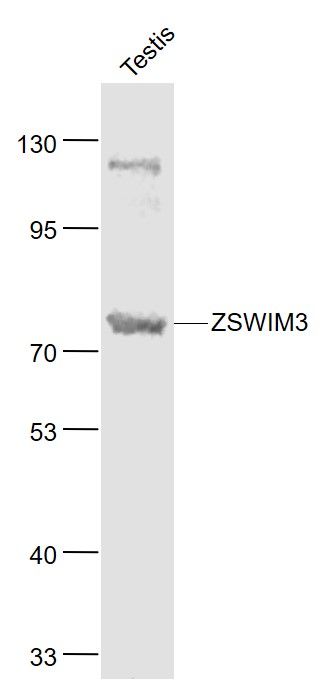Zinc-finger proteins contain DNA-binding domains and have a wide variety of functions, most of which encompass some form of transcriptional activation or repression. ZSWIM3 (Zinc finger SWIM domain-containing protein 3) is a 696 amino acid protein that contains one SWIM-type zinc finger. SWIM domains are found in a variety of eukaryotic and prokaryotic proteins and are thought to be critical for certain ubiquitination reactions. The gene encoding ZSWIM3 maps to human chromosome 20, which contains nearly 63 million bases that encode over 600 genes, some of which are associated with Creutzfeldt-Jakob disease, amyotrophic lateral sclerosis, spinal muscular atrophy, ring chromosome 20 epilepsy syndrome and Alagille syndrome.
Function:
The BBSome complex is required for ciliogenesis but is dispensable for centriolar satellite function. This ciliogenic function is mediated in part by the Rab8 GDP/GTP exchange factor, which localizes to the basal body and contacts the BBSome. Rab8(GTP) enters the primary cilium and promotes extension of the ciliary membrane. Firstly the BBSome associates with the ciliary membrane and binds to RAB3IP/Rabin8, the guanosyl exchange factor (GEF) for Rab8 and then the Rab8-GTP localizes to the cilium and promotes docking and fusion of carrier vesicles to the base of the ciliary membrane.
Subunit:
Part of BBSome complex, that contains BBS1, BBS2, BBS4, BBS5, BBS7, BBS8, BBS9 and BBIP10. The BBSome complex binds to PCM1 and tubulin. Binds to phosphoinositides.
Subcellular Location:
Cell projection, cilium membrane. Cytoplasm. Cytoplasm, cytoskeleton, cilium basal body.
DISEASE:
Defects in BBS5 are a cause of Bardet-Biedl syndrome type 5 (BBS5) [MIM:209900]. Bardet-Biedl syndrome (BBS) is a genetically heterogeneous disorder characterized by usually severe pigmentary retinopathy, early onset obesity, polydactyly, hypogenitalism, renal malformation and mental retardation. Secondary features include diabetes mellitus, hypertension and congenital heart disease. A relatively high incidence of BBS is found in the mixed Arab populations of Kuwait and in Bedouin tribes throughout the Middle East, most likely due to the high rate of consaguinity in these populations and a founder effect.
Similarity:
Belongs to the BBS5 family.
SWISS:
Q96MP5
Gene ID:
140831
Database links:
Entrez Gene: 140831 Human
Entrez Gene: 67538 Mouse
Entrez Gene: 311630 Rat
SwissProt: Q96MP5 Human
SwissProt: Q8CFL8 Mouse
| Picture |
Sample:
Testis (Mouse) Lysate at 40 ug
Primary: Anti-ZSWIM3 (SL9138R) at 1/1000 dilution
Secondary: IRDye800CW Goat Anti-Rabbit IgG at 1/20000 dilution
Predicted band size: 79 kD
Observed band size: 79 kD
|
|
|
